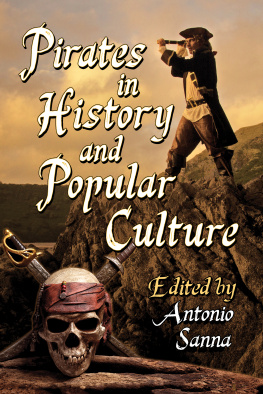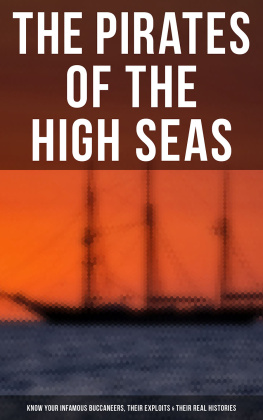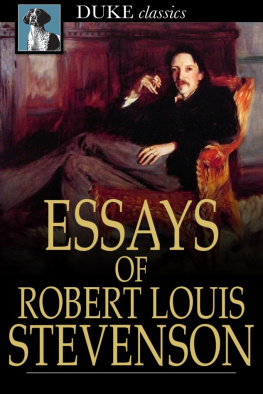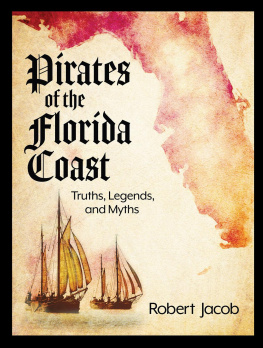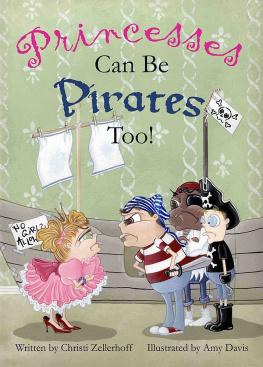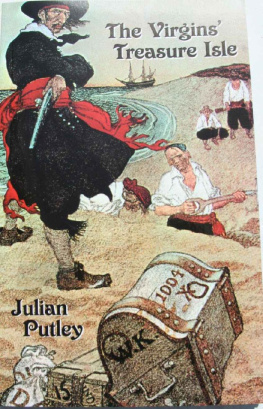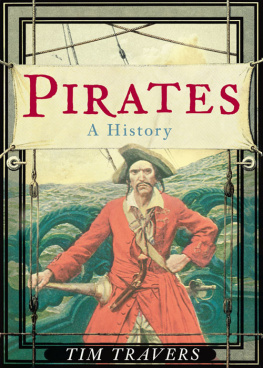Antonio Sanna - Pirates in History and Popular Culture
Here you can read online Antonio Sanna - Pirates in History and Popular Culture full text of the book (entire story) in english for free. Download pdf and epub, get meaning, cover and reviews about this ebook. year: 2018, publisher: McFarland & Company, genre: Romance novel. Description of the work, (preface) as well as reviews are available. Best literature library LitArk.com created for fans of good reading and offers a wide selection of genres:
Romance novel
Science fiction
Adventure
Detective
Science
History
Home and family
Prose
Art
Politics
Computer
Non-fiction
Religion
Business
Children
Humor
Choose a favorite category and find really read worthwhile books. Enjoy immersion in the world of imagination, feel the emotions of the characters or learn something new for yourself, make an fascinating discovery.
- Book:Pirates in History and Popular Culture
- Author:
- Publisher:McFarland & Company
- Genre:
- Year:2018
- Rating:5 / 5
- Favourites:Add to favourites
- Your mark:
- 100
- 1
- 2
- 3
- 4
- 5
Pirates in History and Popular Culture: summary, description and annotation
We offer to read an annotation, description, summary or preface (depends on what the author of the book "Pirates in History and Popular Culture" wrote himself). If you haven't found the necessary information about the book — write in the comments, we will try to find it.
Pirates in History and Popular Culture — read online for free the complete book (whole text) full work
Below is the text of the book, divided by pages. System saving the place of the last page read, allows you to conveniently read the book "Pirates in History and Popular Culture" online for free, without having to search again every time where you left off. Put a bookmark, and you can go to the page where you finished reading at any time.
Font size:
Interval:
Bookmark:


McFarland & Company, Inc., Publishers
Jefferson, North Carolina
LIBRARY OF CONGRESS CATALOGUING DATA ARE AVAILABLE
BRITISH LIBRARY CATALOGUING DATA ARE AVAILABLE
e-ISBN: 978-1-4766-3309-1
2018 Antonio Sanna. All rights reserved
No part of this book may be reproduced or transmitted in any form or by any means, electronic or mechanical, including photocopying or recording, or by any information storage and retrieval system, without permission in writing from the publisher.
Front cover image 2018/ands456/waewkid/iStock
McFarland & Company, Inc., Publishers
Box 611, Jefferson, North Carolina 28640
www.mcfarlandpub.com
To my school colleagues,
who have always encouraged and supported me,
and to my friends,
who have enjoyed and shared my jovial spirit.
Fascination with pirates, their looks and habits, as well as their nefarious actions that span the seas of the entire globe, is an established phenomenon in contemporary culture that has rarely ceased to capture public attention since the 17th century. Actual pirates have inspired the fictional works of hundreds of writers throughout the past three centuries and they have been represented in ballads, folklore, literature, film for cinema and television that generally glorify the pirates daring and lack of scruples. Three hundred years after their most renown, ill-fated actions, pirates have thus become strongly established in the popular imagination. However, the most sordid and cruel aspects that characterize these historical figures have been dismissed in favor of a romanticized version, one that portrays the typical pirate as an antiheroic adventurer and noble outlaw. Such an interpretation is partly legitimized by the very root of the Greek term peiran, which means to dare (Alessandro Aresu, qtd. in Ambrosini and Bartolini 105). The fascination with pirates lies primarily in their disregard for societal rules and conventions, their continuous dynamism, and the constant dangers they face when measuring up against such forces as nature (especially storms and tropical forests) as much as against other human beings. Pirates are figures of cultural anarchy, of rebellion against the status quo.
Although a great many volumes have been dedicated to the history of these sea marauders, critical attention is lacking in terms of their relevance in popular culture and their presence in such media genres as literature, opera, cinema, television, merchandise, manga, and anime. Historical studies on piracy currently on the market include David Cordinglys Under the Black Flag (1995), Cruz Apesteguis Pirates of the Caribbean (2002), Angus Kostams Pirates: Terror on the HighSeas (2001), Nigel Cawthornes A History of Pirates (2003), Peter Earles The Pirate Wars (2003), Markus Redikers Villains of All Nations (2004), and Colin Woodards The Republic of Pirates (2007). These volumes offer a detailed analysis of the history of pirates around the world, but they do not examine subsequent representations in various media. Moreover, these studies do not offer a full roster of interdisciplinary interpretations from such fields as philosophy, gender and queer studies, and psychology. Minoritarian concerns, such as those relating to indigenous identities among pirates and same-sex attraction, have received fleetingif anycritical attention. Homosexuality among pirates is a theme treated only by B.R. Burg in Sodomy and the PirateTradition (1995) and Hans Turley in Rum, Sodomy and the Lush (2001). Both volumes analyze the masculine identity and gender issues of historical pirates, but they do not apply such a study to contemporary representations of them in popular culture.
Book-length publications such as Robert Gardiners Cogs, Caravel and Galleons (1992) and Angus Konstams The Pirate Ship 16601730 (2003) focus instead on the shape and use of the vessels used by historical pirates. Likewise, Robert C. Ritchies Captain Kidd and the War Againstthe Pirates (1988), Richard Zacks The Pirate Hunter (2002), Diana and Michael Prestons A Pirate of Exquisite Mind (2004), and Dan Parrys Blackbeard (2006) are concerned with the history of single buccaneers and pirates. The latter studies do not provide readers with analyses of recent and contemporary representations. The only volume that dedicates part of its contents to contemporary representations of pirates is David Cordinglys Life Among Pirates: The Romance and the Reality (1995), although it presents only a single chapter on the representation of pirates in cinema. Furthermore, Cordinglys volume is not recent enough to include a study of contemporary cinematic productions and it excludes the representation of pirates in other media.
The essays included in this collection have been produced by scholars in diverse fields such as popular culture studies, literature, womens and gender studies, philosophy, and film and media studies. They illuminate a broad spectrum of perspectives on the figure of the pirate, examining both old and new representations as well as studying both global and local characterizations of the figure. The picture that emerges from the 20 essays constituting this collection is therefore variegated and will allow readers already familiar with the history of pirates to discover many aspects of the subject that have been previously ignored in those volumes that focus specifically on historical pirates. On the other hand, readers who are not familiar with the history of pirates will be able to access both a general outline and specific angles of interpretation, especially in those essays that examine the similarities and differences between real pirates and their fictional representations.
The following essays explore several facets of this popular character both in terms of historical and contemporary accounts. This volume is, in fact, divided into four sections that are dedicated to the representation of pirates in history, literature, cinema and television, and other media. The first section of the book focuses on the history of piracy. Contrary to the numerous volumes published in the past on the subject, the five essays constituting this section offer specific case studies that have been previously ignored (or only partially mentioned) by scholars. The methodologies adopted by the contributors differ significantly from each other, thus offering the reader a variegated and compelling picture of the real world of piracy. Three of the essays analyze the habits and customs of historical pirates by focusing on their progressivism, their democratic ideals, their business policies, and their utopian lifestyle.
The first essay, by Antonio Sanna, reconstructs the development of the figure of the pirate by tracing its origins in history and then identifying its multiple fictional incarnations in different media such as literature, cinema, and television. The essay thus works as an instructive and formative introduction to the subject covered by the book, especially for those readers who are not completely familiar with it. In the second essay, Clint Jones maintains the argument that it is the successful utopianism of golden age pirates that today permits such a mythology to overcome the moral ambiguity often associated with piratical behavior. Christopher Ketchams essay examines how pirates were adept at goal setting, project management, risk management, and team buildingskills that small and large enterprises require today. His essay therefore explores how the pirate business model may be adapted to serve contemporary business. The next essay of the section, by Nick Marsellas, explores a minority group present within the pirate community during the golden age, homosexual pirates, and considers the more violent aspect of such relationships. The last essay of part one, by Jayson Althofer and Brian Musgrove, examines the anachronistic pirate coven that was created by the Lindsay brothers in mid20th-century Australia. This group was founded on an elitist-utopian vision of a world based on the Rabelaisian doctrine of Do What You Will and Nietzsches Beyond Good and Evil.
Next pageFont size:
Interval:
Bookmark:
Similar books «Pirates in History and Popular Culture»
Look at similar books to Pirates in History and Popular Culture. We have selected literature similar in name and meaning in the hope of providing readers with more options to find new, interesting, not yet read works.
Discussion, reviews of the book Pirates in History and Popular Culture and just readers' own opinions. Leave your comments, write what you think about the work, its meaning or the main characters. Specify what exactly you liked and what you didn't like, and why you think so.

